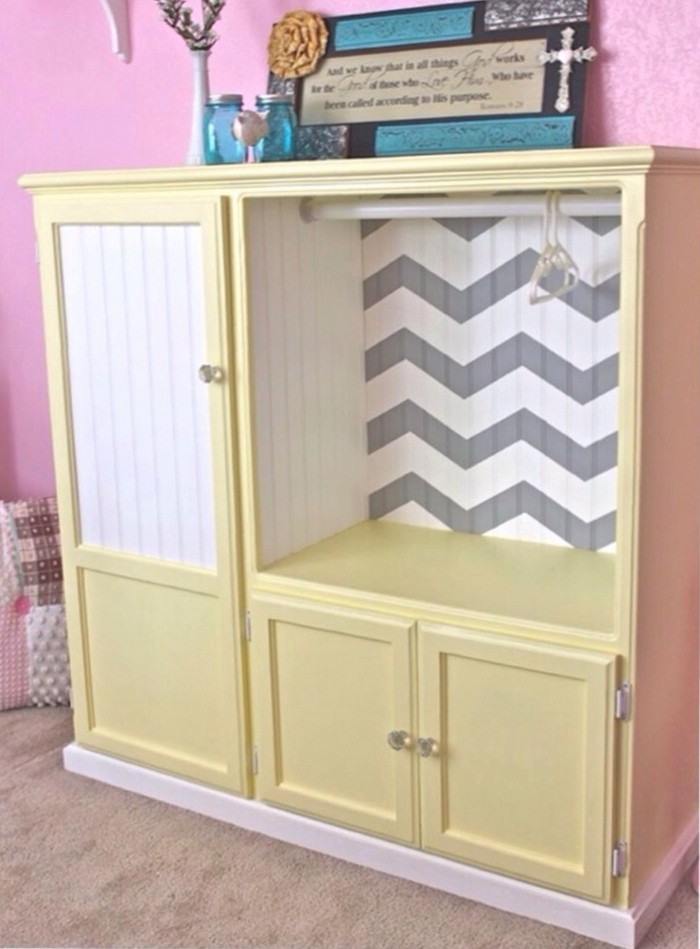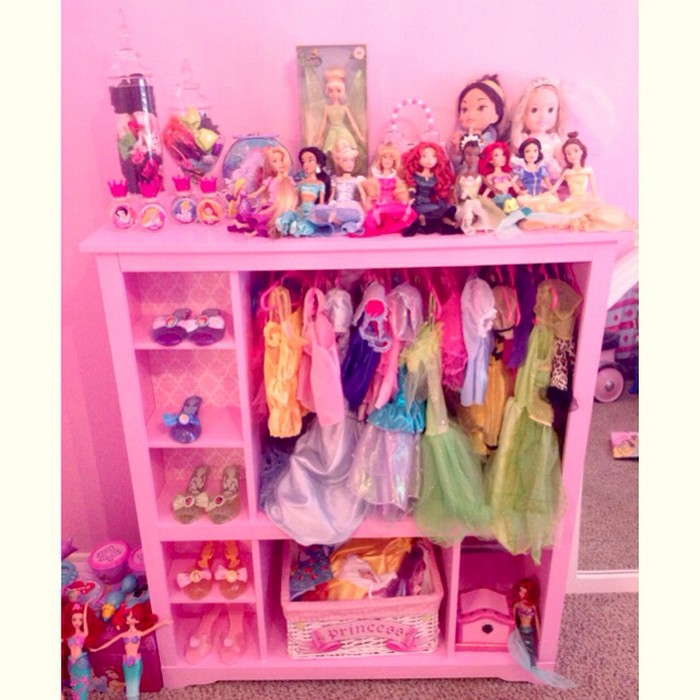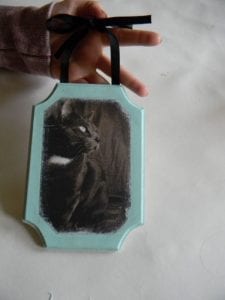Last Updated on February 21, 2024 by teamobn

An old entertainment center is a piece of furniture that is designed to hold a television set and other electronic equipment. It is typically made of wood or particle board and may include features such as shelves, drawers, and cabinets. entertainment centers were once a popular type of furniture, but they have largely been replaced by newer and more modern designs.
But what happens to the old entertainment center if you don’t need them anymore? Well, here’s a nice idea for the kids – an old entertainment center turned into a dress-up closet!
We’ve already featured a DIY play kitchen out of an old entertainment center, but this is a repurposing project you can do if your youngsters enjoy dressing up more than cooking!
A kid’s armoire is a great storage option for kids’ bedrooms. Armoires offer ample storage space for clothes, toys, and other belongings and can help keep a child’s bedroom organized and tidy.
Armoires come in a variety of styles and sizes, so it is important to decide on one that will fit well in the child’s bedroom and meet their storage needs.

This piece of furniture can be easily transformed into a closet with a few simple modifications. By removing the shelves and adding a few hooks, you can create a space that is perfect for storing clothes and toys. This is a great project for anyone looking for a way to upcycle an old piece of furniture.
Depending on the condition of your old furniture, your makeover might require a little more work. But basically, it’s a very easy DIY project you will definitely enjoy!
If your furniture is in good condition, you can simply sand it down and repaint it. This will give it a whole new look and feel. If your furniture is in need of a little more work, you can replace unsafe parts, sand it down, repaint it, and even refinish it. This will give it a brand-new look that will last for years.

After repainting the old entertainment center, you can add detailed accessories to complete your child’s mini wardrobe. Add a mirror to one side of the center, and then a rod for hanging clothes on the other side. With these two simple additions, your child’s mini wardrobe will be complete!
You might also need to add or adjust shelving for more clothes/shoe storage. This will ensure that your kid’s belongings are organized and you have the space you need. Additionally, it will help to keep your closet looking neat and tidy.
This old entertainment center armoire would make the perfect little closet for a child’s room. It’s a great way to upcycle a piece of furniture and give a child a fun and functional space to call their own. Plus, who wouldn’t love having their very own closet? If you’ve got a very large entertainment center, you can even use it as your kid’s ‘real’ closet. ?
Contents
A little closet for the little one. Is there any child who wouldn’t love this old entertainment center armoire?
See more cute examples from our album and learn how our featured kid’s armoire was made by heading over to the article linked below!
Upcycling an Entertainment Center to a Kids Armoire
Materials
- Old Entertainment Center
- Wood Casing
- Primer and Paint
- White Spray Paint
- Wrapping Paper
- Mirror
- Heavy-duty Liquid Adhesive for glass
- Metal Closet Rod
- Bins
Tools
- Screwdriver
- Scoring Tool
- Metal Square
- Clamps
Instruction
Step 1: Preparation
- Clean the Entertainment Center: Begin by cleaning the old entertainment center thoroughly to remove dust and dirt. This will ensure that the paint adheres properly.
- Remove Unnecessary Components: Use the screwdriver to remove any parts that won’t be needed, such as old hardware, glass doors, or shelves that won’t fit the new design.
Step 2: Planning and Measuring
- Measure for the Closet Rod: Decide where you want the closet rod to go. Typically, it should be high enough to hang clothes without touching the bottom.
- Plan for Shelves and Bins: Determine where you want additional shelves or spaces for bins. Use the metal square to ensure your measurements are precise and mark the locations with a pencil.
Step 3: Modifying Structure
- Add Wood Casing: If you’re adding new sections or need to reinforce the structure, cut wood casing to size and use clamps to hold them in place while you secure them with screws.
- Install Closet Rod: Secure brackets for the metal closet rod at the measured height, ensuring they are level. Then, place the rod in the brackets.
Step 4: Painting
- Apply Primer: Once all structural changes are made, apply a coat of primer to the entire piece. This will help the paint adhere better and ensure a uniform finish.
- Paint the Armoire: After the primer dries, paint the armoire with your chosen color. Use white spray paint for hard-to-reach areas or for a finer finish on detailed sections.
Step 5: Decorating
- Apply Wrapping Paper: For a decorative back panel, measure, cut, and use the scoring tool to crease the wrapping paper to fit. Apply it to the back wall of the armoire with heavy-duty liquid adhesive.
- Attach the Mirror: Decide on the location for the mirror, apply heavy-duty liquid adhesive to its back, and carefully press it into place. Ensure it’s securely attached before letting go.
Step 6: Final Touches
- Add Bins and Shelves: Place bins on the shelves you’ve designated for storage. If you’ve made additional shelves, ensure they’re securely installed at this stage.
- Reattach Doors or Add Curtains: If you removed doors, reattach them now or consider adding curtains for an open, easily accessible storage area.
Step 7: Inspection and Adjustment
- Inspect Your Work: Go over the entire armoire to ensure everything is secure. Check that the paint is evenly applied and that all decorative elements are firmly in place.
- Make Adjustments: If you find any issues, such as uneven paint or loose screws, address them now. Ensure the closet rod is firmly in place and can hold weight.
Step 8: Enjoy Your Kids Armoire
Place the armoire in your child’s room and organize their clothing, toys, and other belongings in the new, custom space. Enjoy the functionality and beauty of your newly created kids armoire, knowing you’ve created a unique piece that’s both practical and stylish.
Safety Tips for DIY Furniture Projects
Embarking on DIY furniture projects, such as turning an old entertainment center into a creative kids armoire, is an exciting way to add a personal touch to your home while recycling unused pieces. However, safety should always be your top priority, especially when the project is for a child’s room.
Below are essential safety tips to ensure your DIY endeavor results in a beautiful piece and is carried out safely.
Plan Ahead
Before starting your kids armoire project, thoroughly plan each step. Ensure you have all the necessary tools and materials on hand to avoid mid-project runs to the store, which can lead to hurried, unsafe work practices. Read through instructions or tutorials to familiarize yourself with the process and identify any potential hazards.
Wear Protective Gear
Always wear the appropriate protective gear. This includes safety glasses to protect your eyes from dust and debris, gloves to shield your hands from sharp objects and splinters, and a dust mask, especially when sanding or painting, to prevent inhalation of harmful particles.
Secure Your Workspace
Keep your workspace clean and well-organized. Ensure there’s adequate lighting and enough space to move around safely. Securely clamp down pieces you’re working on to prevent them from shifting and causing accidents. If you’re working with power tools, make sure they are properly maintained and that you are familiar with their operation.
Avoid Toxic Materials
Opt for non-toxic, child-safe options when selecting paints, adhesives, and finishes for your kids armoire. Volatile Organic Compounds (VOCs) found in many paints and finishes can harm the environment and your family’s health. Look for products with low VOC levels or natural alternatives.
Keep Tools Out of Children’s Reach
Ensure that all tools and materials are kept out of reach of children. This not only protects them from harm but also prevents any unintended interruptions that could lead to accidents. Educate family members about the importance of not disturbing the workspace.
Furniture Stability
One of the most crucial aspects of creating a kids armoire for children is ensuring its stability. Secure the armoire to the wall with furniture anchors to prevent it from tipping over. This is especially important in a kids’ room where children might climb on furniture or pull on doors and drawers.
Smooth Edges and Corners
Pay special attention to edges and corners as you transform the entertainment center into an armoire. Use sandpaper to smooth out any rough areas to prevent scratches or cuts. Consider adding corner guards to sharp edges for additional safety.
Regular Checks and Maintenance
After completing your project, regularly check the armoire for any loose screws, worn-out parts, or sharp edges that may have developed over time. Keeping the furniture well-maintained ensures it remains safe for use and extends its lifespan.
Click on any image to start the lightbox display. Use your Esc key to close the lightbox.![]()












Guidelines for Selecting the Right Entertainment Center
Transforming an old entertainment center into a charming kids armoire can be a rewarding DIY project that breathes new life into unused furniture and adds a unique storage solution to your child’s room. However, the success of this transformation largely depends on selecting the right entertainment center to repurpose.
Here are some guidelines to help you choose the best piece for your project, ensuring that your kids armoire looks great and is functional and safe.
Assess the Size
The size of the entertainment center is a critical factor to consider. It needs to be proportionate to the space available in your child’s room, leaving enough clearance for doors and drawers to open comfortably.
Additionally, consider the future storage needs of your child. A larger entertainment center might be more suitable if you anticipate needing more storage space for clothes, toys, and other belongings as your child grows.
Check the Material Quality
The material of the entertainment center is pivotal for durability and safety. Solid wood entertainment centers are ideal for repurposing into kids armoires due to their sturdiness and ease of modification.
Avoid units made from particle board or other materials that may not withstand the wear and tear of being repurposed or the active use by a child. Solid wood can also be sanded, painted, or stained more effectively, allowing for a more personalized and durable finish.
Evaluate the Structure
Inspect the structural integrity of the entertainment center. It should be sturdy and free from major damages such as deep cracks, warping, or loose joints. Minor scratches or dents can be fixed or covered up during the transformation process, but the overall structure needs to be sound to ensure the safety and longevity of your kids armoire.
Consider the Design
The entertainment center’s design plays a significant role in its potential as a kids armoire. Look for features that can be easily adapted, such as adjustable shelves, spacious cabinets, or compartments that can serve as drawers. The more versatile the design, the easier it will be to customize the piece to fit your child’s storage needs.
Safety Features
Safety should never be compromised. Opt for entertainment centers with a stable base to minimize the risk of tipping over. If the piece comes with glass doors or shelves, consider the safety implications and whether the glass can be replaced with a safer material or if it needs to be secured with additional safety measures.
Aesthetic Potential
While functionality and safety are paramount, the aesthetic appeal of the entertainment center is also important, especially when turning it into a kids armoire. Choose a piece that matches or can be easily adapted to your child’s bedroom decor. The style, color, and hardware can all be modified, but starting with an entertainment center with a pleasing shape or decorative details can make the transformation process smoother and more enjoyable.
Environmental Consideration
Finally, repurposing an entertainment center into a kids armoire is a fantastic way to recycle and reduce waste. Selecting the right piece gives it a new lease on life and contributes to a more sustainable living approach. Consider sourcing the entertainment center from thrift stores, garage sales, or online marketplaces where used furniture can be found, further enhancing the environmental benefits of your project.
Organizational Strategies for Kids Armoires
Turning an old entertainment center into a kids armoire is a fantastic way to repurpose furniture and offers a unique solution to organize your child’s belongings efficiently. A well-organized kids armoire can help keep a child’s room tidy and make it easier for them to find what they need. Here are some organizational strategies for maximizing the functionality and convenience of your kids armoire.
Utilize Adjustable Shelving
One of the key features to look for or create in a kids armoire is adjustable shelving. This allows you to customize the interior space according to the size of the items you need to store, whether it’s clothing, toys, or books. By adjusting the shelves to fit the items perfectly, you can maximize the use of space and keep everything neatly organized.
Implement Clothing Rods
Incorporating clothing rods into the kids armoire is essential for hanging items such as dresses, shirts, and jackets. Positioning the rod at a height that allows your child to reach their clothes encourages independence and helps keep the room tidy. If space allows, consider installing multiple rods at different heights to separate clothing by type or season.
Add Bins and Baskets
Bins and baskets are versatile for organizing smaller items in a kids armoire. Use them to store toys, art supplies, undergarments, and socks. Labeling each bin or basket helps your child know where everything goes, making clean-up easier and more efficient. Choosing bins that neatly fit the kids armoire’s shelves can also enhance the overall appearance.
Incorporate Drawer Dividers
If your kids armoire has drawers, drawer dividers can be a game-changer for the organization. They allow you to separate different types of clothing or items, keeping everything in its place. This is particularly useful for smaller items that tend to get jumbled together, such as socks, underwear, and accessories.
Use the Door Space
Don’t overlook the inside of the kids armoire doors as valuable organizational real estate. Installing hooks or hanging organizers on the doors of the kids armoire can provide extra storage space for accessories, hats, or even shoes. This strategy makes use of often-forgotten space and keeps frequently used items within easy reach.
Dedicate Areas for Different Items
Organize the kids armoire by dedicating specific areas for different types of items. For example, one section can be for clothing, another for toys, and another for books or school supplies. This helps keep the armoire organized and makes it easier for your child to find what they’re looking for without disrupting the entire space.
Regular Maintenance
Finally, maintaining the organization of the kids armoire is just as important as setting it up. Encourage your child to participate in regular clean-ups and return items in designated spots. Periodically re-evaluating the organization system and making adjustments as your child grows or their needs change ensures the kids’ armoire remains a practical and cherished piece in their room.
By implementing these organizational strategies, the kids’ armoire can become a cornerstone of tidiness and efficiency in your child’s room. Not only will it help keep the space looking neat, but it will also teach your child valuable lessons in organization and responsibility.
Conclusion
Crafting a kids armoire out of an old entertainment center is a creative and rewarding DIY project that breathes new life into outdated furniture while providing a functional and personalized storage solution for your child’s room. Following the detailed steps using the listed materials and tools, you can transform a once-discarded piece into a cherished item filled with character and purpose.








